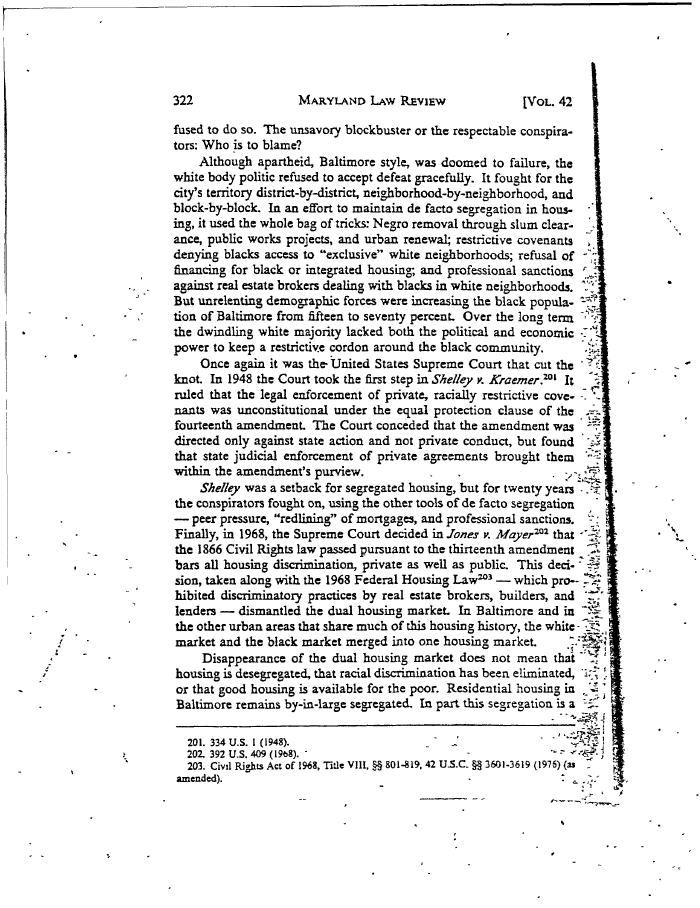 |
||||
|
Garrett Power, Apartheid Baltimore Style: The Residential Segregation Ordinances of 1910-1913, Maryland Law Review, 42 (1983) , Image No: 35 Enlarge and print image (72K) << PREVIOUS NEXT >> |
 |
||||
|
Garrett Power, Apartheid Baltimore Style: The Residential Segregation Ordinances of 1910-1913, Maryland Law Review, 42 (1983) , Image No: 35 Enlarge and print image (72K) << PREVIOUS NEXT >> |
| 322 MARYLAND LAW REVIEW [VOL. 42 fused to do so. The unsavory blockbuster or the respectable conspira- tors: Who is to blame? Although apartheid, Baltimore style, was doomed to failure, the white body politic refused to accept defeat gracefully. It fought for the city's territory district-by-district, neighborhood-by-neighborhood, and block-by-block. In an effort to maintain de facto segregation in hous- ing, it used the whole bag of tricks: Negro removal through slum clear- ance, public works projects, and urban renewal; restrictive covenants denying blacks access to "exclusive" white neighborhoods; refusal of financing for black or integrated housing; and professional sanctions against real estate brokers dealing with blacks in white neighborhoods. But unrelenting demographic forces were increasing the black popula- tion of Baltimore from fifteen to seventy percent. Over the long term the dwindling white majority lacked both the political and economic power to keep a restrictive cordon around the black community. Once again it was the- United States Supreme Court that cut the knot. In 1948 the Court took the first step in Shelley y. Kraemer.201 It ruled that the legal enforcement of private, racially restrictive cove- nants was unconstitutional under the equal protection clause of the fourteenth amendment. The Court conceded that the amendment was directed only against state action and not private conduct, but found that state judicial enforcement of private agreements brought them within the amendment's purview. Shelley was a setback for segregated housing, but for twenty years the conspirators fought on, using the other tools of de facto segregation — peer pressure, "redlining" of mortgages, and professional sanctions. Finally, in 1968, the Supreme Court decided in Jones v. Mayer202 that the 1866 Civil Rights law passed pursuant to the thirteenth amendment bars all housing discrimination, private as well as public. This deci-' sion, taken along with the 1968 Federal Housing Law203 — which pro- hibited discriminatory practices by real estate brokers, builders, and lenders — dismantled the dual housing market. In Baltimore and in the other urban areas that share much of this housing history, the white market and the black market merged into one housing market. Disappearance of the dual housing market does not mean that housing is desegregated, that racial discrimination has been eliminated, or that good housing is available for the poor. Residential housing in Baltimore remains by-in-large segregated. In part this segregation is a 201. 334 U.S. I (1948). 20Z 392 U.S. 409 (19b8).' 203. Civil Rights Act of 1969, Title VIII, §§ 801-819. 42 amended). 3601-3619 (1976) (at |